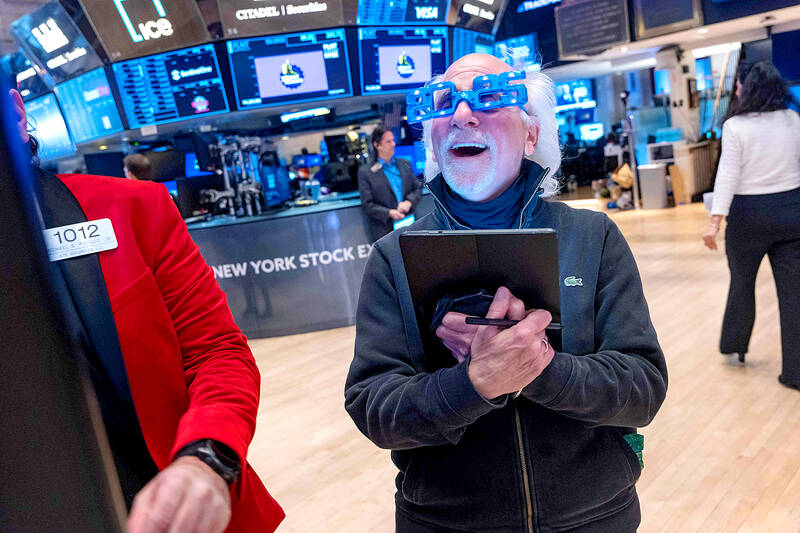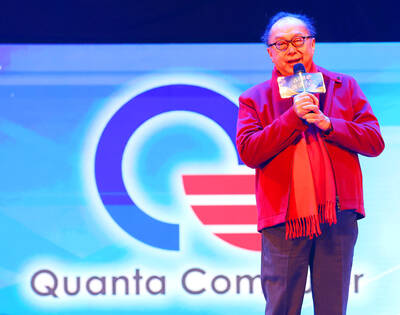Despite political upheavals, stock markets and bitcoin smashed records last year, fuelled by investor enthusiasm for artificial intelligence (AI), falling interest rates and hopes of tax cuts.
Here are four of the most remarkable aspects of year for financial markets:
STOCK RECORDS FALL LIKE DOMINOES

Photo: AFP
Wall Street’s three main stock indices blew past record highs to set new peaks last year, with the Dow Jones Industrial Average climbing above 45,000 points, the S&P 500 above 6,000 and the NASDAQ Composite above 20,000.
“It was an exceptional year, driven by the performance of tech shares thanks to artificial intelligence,” Pictet Asset Management Ltd senior investment adviser Christopher Dembik said.
The Dow ended the year up by about 13 percent, while the S&P 500 and the NASDAQ, which have more tech stocks, notched annual gains of more than 23 percent and about 29 percent respectively.
Shares in Nvidia Corp, which makes processors particularly adept at running AI models, including applications such as ChatGPT, rose more than 170 percent last year.
“It’s now been about two years that ChatGPT was launched and it’s been two years that the AI buzz pushed some US Big Tech companies to the sky,” Swissquote Bank Ltd senior analyst Ipek Ozkardeskaya said.
“Nvidia, which has become the icon of the AI rally, gained almost 1,000 percent since then, the Magnificent Seven nearly 100 percent since last November,” she added.
In Europe, records also fell, but the gains were less marked. Frankfurt’s DAX, driven by business software developer SAP AG (up 70 percent) broke the 20,000-point level and finished the year with a gain of 18.9 percent.
Tokyo’s Nikkei 225 index gained almost 20 percent last year, finally surpassing the high seen before Japan’s asset bubble burst in the 1990s.
A VERY POLITICAL YEAR
US president-elect Donald Trump’s victory in November’s election gave Wall Street even more of a boost on hopes he would follow through on pledges of deregulation and tax cuts.
“The market considered that will mean more growth and for longer,” Myria Asset Management SAS director Pierre Bismuth said.
However, political developments did not always help investors. Look at France: President Emmanuel Macron’s calling of early parliamentary elections backfired with no clear winner, and the Paris CAC 40, which had been up more than 6 percent ahead of the election, ended last year down more than 2 percent.
Weakness in China further dragged down luxury stocks.
This year, investors are keeping a wary eye to see if Trump implements threatened tariff hikes, as well as the outcome of early elections in Germany next month.
BITCOIN, GOLD AND COMMODITIES
Bitcoin rode expectations of deregulation under Trump to break US$100,000, rising more than 120 percent. Ethereum grew by more than 40 percent, even if it did not set a new all-time record.
Gold also set a new record, as it benefitted from its safe-haven appeal during times of geopolitical tensions.
Commodities such as coffee and cocoa set new records as poor weather caused supply concerns, with prices of the premium arabica coffee gaining about 67 percent in New York last year to break past the highest levels in more than 40 years, while cocoa gained 172 percent.
However, soybeans took the spot as the worst-performing major commodity last year. Ample production in the US and Brazil, combined with a slowdown in Chinese demand, drove prices down about 24 percent for the year — the biggest annual drop in two decades.
MONETARY POLICY ROLLER COASTER
The central banks of the US and some EU countries finally began to cut interest rates they had hiked to tame an inflation spike triggered by the post-COVID-19 pandemic recovery and the Russian invasion of Ukraine.
Switzerland got the ball rolling in March, followed by the European Central Bank in June and the Bank of England and the US Federal Reserve in September.
Investors as well as central banks were anxious about the pace of interest rate cuts: Not too fast to reignite inflation, but not so slow that activity falls.
Trading sometimes turned volatile as investors interpreted economic data through the prism of its impact on the Fed’s likelihood to cut rates.
The US central bank has been paring back expectations of further rate cuts, especially as Trump’s tariffs could spark fresh inflationary pressures, while the ECB is expected to continue cutting rates, given stagnant growth in the eurozone.

Intel Corp chief executive officer Lip-Bu Tan (陳立武) is expected to meet with Taiwanese suppliers next month in conjunction with the opening of the Computex Taipei trade show, supply chain sources said on Monday. The visit, the first for Tan to Taiwan since assuming his new post last month, would be aimed at enhancing Intel’s ties with suppliers in Taiwan as he attempts to help turn around the struggling US chipmaker, the sources said. Tan is to hold a banquet to celebrate Intel’s 40-year presence in Taiwan before Computex opens on May 20 and invite dozens of Taiwanese suppliers to exchange views

Application-specific integrated circuit designer Faraday Technology Corp (智原) yesterday said that although revenue this quarter would decline 30 percent from last quarter, it retained its full-year forecast of revenue growth of 100 percent. The company attributed the quarterly drop to a slowdown in customers’ production of chips using Faraday’s advanced packaging technology. The company is still confident about its revenue growth this year, given its strong “design-win” — or the projects it won to help customers design their chips, Faraday president Steve Wang (王國雍) told an online earnings conference. “The design-win this year is better than we expected. We believe we will win

Quanta Computer Inc (廣達) chairman Barry Lam (林百里) is expected to share his views about the artificial intelligence (AI) industry’s prospects during his speech at the company’s 37th anniversary ceremony, as AI servers have become a new growth engine for the equipment manufacturing service provider. Lam’s speech is much anticipated, as Quanta has risen as one of the world’s major AI server suppliers. The company reported a 30 percent year-on-year growth in consolidated revenue to NT$1.41 trillion (US$43.35 billion) last year, thanks to fast-growing demand for servers, especially those with AI capabilities. The company told investors in November last year that

Power supply and electronic components maker Delta Electronics Inc (台達電) yesterday said it plans to ship its new 1 megawatt charging systems for electric trucks and buses in the first half of next year at the earliest. The new charging piles, which deliver up to 1 megawatt of charging power, are designed for heavy-duty electric vehicles, and support a maximum current of 1,500 amperes and output of 1,250 volts, Delta said in a news release. “If everything goes smoothly, we could begin shipping those new charging systems as early as in the first half of next year,” a company official said. The new